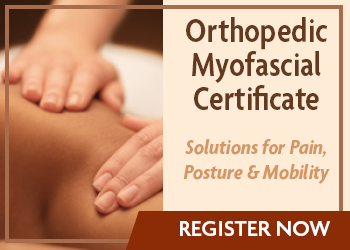Give Yourself a Hand and Don’t get all Bent Out of Shape!
- Before work, practice mindful deep breathing and perform some gentle stretching warmup exercises to improve circulation and warmth. Reach arms overhead, behind your back, flex and extend elbows, wrists and fingers, open and close palms. Do some basic body stretches and limber up for the work.
- Keep yourself hydrated and fit. Get plenty of sleep, good nutrition, and a regular fitness regimen to boost energy, endurance and power for more great therapy.
- Schedule a reasonable number of clients at a time, with breaks for rest or a nap between sessions to avoid fatigue.
- Use proper foot placement and stance when practicing manual therapy. Assume a neutral posture with one foot ahead of the other, as if taking a step, with knees slightly bent, spine with neutral lumbar lordosis, to enable you to simply lean forward to work with less effort. Learn Tai Chi to master this type of posture and movement.
- Use proper ergonomics when you work: use a high-low electric table, have plenty of room to move around the table, use bolsters and pillows to position clients for access to the body, keep the body part close to you to avoid bending and reaching. Ask for help when lifting heavier loads.
- Employ a large repertoire of techniques and vary the interventions to avoid repetitive strain. Take continuing education courses to maximize your selection. Clients will appreciate the variety!
- Avoid overuse and awkward positions of your body: keep thumbs and fingers in neutral when gliding, do not hyperextend the thumb, fingers or wrist. Stack joints perpendicular to the earth to maximize efficiency and avoid strain to tendons and ligaments. Use gravity to do the work.
- Have fun with massage tools such as foam rollers, handheld tools, balls and massage cups.
- Avoid repeated or sustained positions and pinching or gripping. Alternate techniques and use both or alternating hands, elbows, knuckles, forearms to ease your strain.
- Use less force. You can access deep structures with many gentle techniques, including myofascial release, positional release/strain-counterstrain, craniosacral therapy and neuromuscular re-education work.
We hope you enjoyed these top ten tips for saving your hands.
Learn more with the Clinical Strategist, Dr. Theresa Schmidt PT at PESI Rehab Summit- Oct. 5-8, 2022
where you can access results-oriented continuing education and make those in-person connections as you elevate your skills to the next level.
Top Tips offered by Dr. Theresa A. Schmidt, PT,DPT,MS,OCS,LMT,CEAS, Educise PC
www.Educise.com

